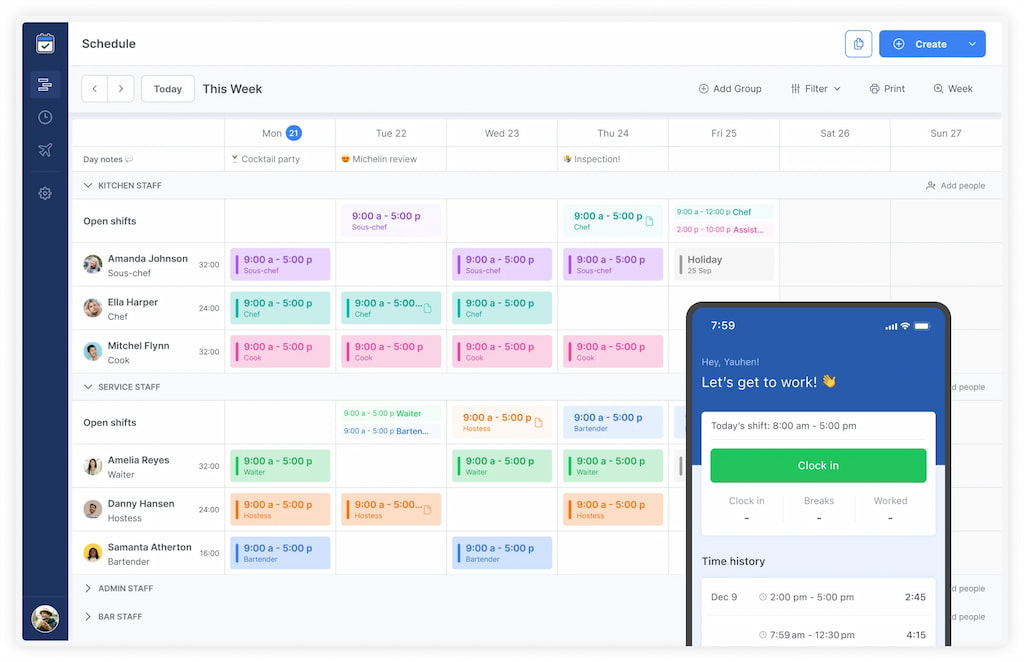Modern work conditions dictate the concept of what is shift work has to become a ubiquitous part of many industries. Businesses and organizations operate round the clock, necessitating flexible work schedules that go beyond the traditional 9-to-5 routine. In this comprehensive guide, we delve into the intricacies of shift patterns, from the best practices to potential legal implications.
Understanding Shift Patterns: A Complete Guide
At its core, a shift pattern refers to a predetermined sequence of work hours and rest periods. It outlines when employees start and finish their work and encompasses a wide array of arrangements, from fixed schedules to rotating shifts.
Shift patterns play a pivotal role in industries that demand continuous operation, such as healthcare, manufacturing, and customer service.
If you’re managing shifts or responsible for scheduling, you understand the challenge of aligning employee preferences with business requirements. Fortunately, mastering popular shift patterns can simplify roster planning and streamline your workplace scheduling.
How to Pick an Ideal Shift Pattern
Selecting the best shift pattern for your business depends on various factors, including the nature of work, employee preferences, and operational requirements.
While no one-size-fits-all answer exists, some patterns have garnered popularity due to their benefits. The classic 9-to-5 remains common, but alternative arrangements like the 12-hour shift or compressed workweek are gaining traction for their potential to boost productivity and employee satisfaction.
Crafting an effective schedule pattern necessitates a delicate balance between the requirements of both employees and employers, with a fundamental focus on ensuring adequate working hours for sustainable livelihoods. Here are actionable steps that can greatly contribute to maximizing scheduling effectiveness:
- Strategic planning: Lay down a comprehensive shift plan that leaves no room for gaps or errors. A well-thought-out schedule forms the foundation of a successful operation.
- Continuous refinement: Regularly monitor your work schedule and swiftly make real-time adjustments if any issues surface. This agility prevents minor glitches from snowballing into major disruptions.
- Eliminate on-call scheduling: Steer clear of on-call scheduling, which tends to be unpredictable and can introduce undue stress into the work environment. A stable, predictable schedule fosters a more balanced and motivated workforce.
- Adaptability to overtime: Cultivate a readiness for overtime work when exigencies demand. Flexibility in staffing during busy periods can be invaluable in maintaining operational efficiency.
- Simplicity over complexity: Opt for a streamlined business model over intricate alternatives. Choose a proven framework relevant to your industry and tailor it to suit your specific organizational dynamics.
- Embrace technology: Bid farewell to paper-based systems and embrace technological solutions. Efficient employee shift scheduling tools not only streamline the process but also enhance accuracy and accessibility.
By meticulously applying these steps, you can significantly elevate your shift scheduling, resulting in a harmonized and optimized work environment. This not only benefits day-to-day operations but also bolsters overall business performance.

Popular Shift Patterns
Certain shift patterns have proven popular due to their balancing act between work and leisure. The 2-2-3 pattern, where employees work two consecutive days, followed by two days off, and then three consecutive days, is a case in point. This arrangement allows for longer breaks, enabling individuals to recharge. But there are many other shift patterns a business can incorporate into its schedule, including:
| Shift pattern | Description | Example | Pros | Cons |
|---|---|---|---|---|
| 8-hour shifts | Consists of 8-hour workdays | 9 AM – 5 PM | Predictable schedule | Shorter recovery time between shifts |
| 12-hour shift | Involves 12-hour workdays | 7 AM – 7 PM | Longer breaks | Fatigue due to long hours |
| Rotating shifts | Shifts that vary in days and times | Day, night, evening shifts | Variety in schedule | Disrupts sleep patterns |
| Split shifts | Splitting a workday into two separate shifts | 10 AM – 2 PM, 6 PM – 10 PM | Extended coverage | Limited time for personal activities |
| Flexitime | Employees choose their work hours within certain limits | Varies | Work-life balance | May require core hours to ensure coverage |
| Compressed work week | Completing a full workweek in fewer days | 4 days x 10 hours | Longer weekends | Longer daily work hours |
| 5 over 7 shift pattern | Working any 5 days out of 7 | Monday – Friday | Regular days off | Variable schedules |
| 4 on 4 off shifts | Working 4 days followed by 4 days off | Rotation schedule | Extended time off | Long workdays, less frequent breaks |
| Staggered day shift | Varying start and end times for employees on the same shift | Varies | Individual preferences | Communication challenges |
| One week on, one week off | Working full-time for a week and having the next week off | 7 days on, 7 days off | Extended time off | Long work hours |
| Alternating weeks | Rotating between two different shifts every other week | Day shift, night shift | Predictable schedule | Frequent changes, potential for confusion |
4 on 4 off shift pattern example
The structure of the 4 on 4 off shift pattern is elegantly straightforward: employees engage in 12-hour shifts over four consecutive days, subsequently enjoying a continuous four-day off for recuperation and rejuvenation. This intentional spacing between each four-day sequence allows staff to recalibrate their internal body clock or restore their circadian rhythm, fostering enhanced overall well-being.
Alternating weeks pattern example
The alternating week schedule artfully blends flexibility with a sense of consistency. Team members are assigned two distinct working patterns – one for the initial week (3 day shifts > 2 evening swing shifts) and another (3 evening shifts > 2 day shifts) for the subsequent week.
An alternating week shift pattern holds particular appeal for industries such as hotels, restaurants, and leisure centers. These sectors often demand workforce availability beyond the confines of the standard 9-to-5:30 workday, yet they endeavor to retain a semblance of regularity in work patterns. Use the best restaurant management software to deal with this pattern.
By adopting the alternating week shift arrangement, these establishments can efficiently balance operational requirements with the individual needs of their employees, resulting in a harmonious synergy between business demands and personal aspirations.
Legal Aspects of Shift Patterns: Considerations and Advice
Implementing shift patterns in the workplace involves more than just operational logistics – it also requires a keen understanding of the legal implications.
Ensuring that your shift patterns comply with labor laws and regulations is crucial to maintaining a fair and harmonious work environment.
Before finalizing any shift pattern, it’s essential to thoroughly comprehend the labor laws and regulations that govern your industry and jurisdiction. Different regions have specific guidelines regarding working hours, rest breaks, overtime, and employee rights. Familiarize yourself with these laws to ensure your shift patterns are in line with legal requirements.
Key considerations
- Working time regulations: Many jurisdictions have legislation that sets limits on the maximum working hours, daily and weekly rest periods, and provisions for breaks during shifts. Ensure your shift patterns adhere to these regulations to prevent violations.
- Overtime and pay: Certain shift patterns may trigger overtime pay and shift differentials based on the number of hours worked. Understand the criteria for overtime and ensure accurate compensation for employees working beyond standard hours.
- Shift length and breaks: Labor laws often define the maximum continuous working hours and minimum rest breaks between shifts. Construct shift patterns that allow employees to have adequate rest and meal breaks as mandated by law.
- Health and safety: Your shift patterns should prioritize employee health and safety. Prolonged or irregular shifts can lead to fatigue and potential safety hazards. Design patterns that mitigate these risks and provide sufficient recovery time between shifts.
- Equal treatment: Ensure that your shift patterns do not discriminate against specific groups of employees based on protected characteristics such as gender, age, or disability. Consistently apply shift allocations and rotations to avoid potential claims of bias.
- Consult legal experts: If you’re uncertain about the legal implications of your shift patterns, seek advice from legal professionals who specialize in labor and employment law. They can provide invaluable insights tailored to your specific circumstances.
- Regular review and updates: Labor laws can change over time. Periodically review your shift patterns to ensure ongoing compliance with evolving regulations. Make necessary adjustments promptly to avoid legal complications.
- Transparent communication: Clearly communicate the shift patterns, working hours, and expectations to your employees. Transparency can help prevent misunderstandings and potential legal disputes.
- Employee consultation: Involve employees in the shift pattern decision-making process. Solicit their input and consider their preferences when designing schedules. This inclusive approach can lead to higher employee satisfaction and compliance.
- Document everything: Maintain accurate records of shift patterns, working hours, breaks, and any modifications. Comprehensive documentation serves as evidence of your commitment to legal compliance and can be invaluable in case of disputes.
Always remember that labor laws can vary widely based on location and industry, so it’s crucial to stay informed and adapt your shift patterns accordingly.
Shifts Patterns: Conclusion
Whether you’re fine-tuning an existing shift pattern or embarking on a complete overhaul, this guide has equipped you with the insights and strategies needed to navigate the intricate realm of shift patterns successfully.
Remember, the world of shift patterns is not static; it evolves alongside your business and industry trends. Stay proactive, remain adaptable, and continue to refine your shift patterns to align with changing demands and optimize your workforce management.
Incorporating Shifts by Everhour into your shift scheduling process can significantly elevate your management capabilities and enhance the employee experience. By embracing such technology, businesses can cultivate a more efficient and harmonious work environment that benefits everyone involved. Remember, while technology streamlines processes, it’s crucial to align its implementation with your organization’s unique needs and culture for optimal results.
If you’re looking for a seamless way to improve shift planning, Shifts by Everhour is the perfect solution. With features like real-time monitoring, easy scheduling, and mobile accessibility, managing your workforce has never been simpler.

